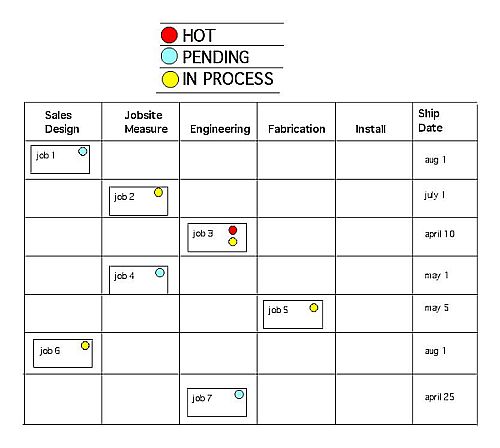Question
I own and run a small granite countertop fabrication shop in south Louisiana, but with the recent hurricanes my business has grown 300% in 6 months. Although my shop is production-ready for the increase, I can't keep up with the job processing paperwork. Does anyone in the cabinet industry have any suggestions as to filing or posting job status from start to finish?
Forum Responses
(Business and Management Forum)
From contributor A:
You have two separate goals here:
1) Developing a system to track paper
2) Developing a system to track projects.
Tracking the paper is probably the simplest. You want to handle this paper as little as possible and you want to be able to find it as quickly as possible. One way to archive paper is according to serial number. Get yourself a self-inking/automatic numbering stamp. This is a rubberstamp gizmo that posts a number each time you stamp a piece of paper and advances that number one digit the next time you punch a piece of paper. This allows you to streamline how the original paper is filed. Paper is stored in sequence, according to serial number. There are no decisions to make about how to label a folder or what folder the paper belongs in. Piece of paper #22 will be found between piece of paper #21 and #23. This handles the storage and retrieval part. Most of the paper that comes into your building will be in black ink - if you use red for this stamp it will stand out better. You can use this serial number storage system with any kind of bookkeeping system. Once the data has been recorded somewhere the only time you will need to put your hands on the original paper is if you need to defend or corroborate something. On this day it will be easy to find.
Project Status is easier to monitor if you start with a list of the possible statuses.
1) Hot Projects: for some reason or another, these should happen now or next.
2) Pending: this is a project that is going to need to happen but has not yet been started.
3) In Process
If you kept a list of work orders posted on the wall and got yourself some self-adhesive colored mailing labels you could track the current status of any particular work order by just sticking a new colored label over the old one. We minimize some of our paper by using different colored hi-liter pens. Yellow indicates boxes have been cut. Orange colors over yellow and indicates the boxes been assembled. Blue overlays orange and this means the doors are installed and we can ship them. This is way better than smudging up the drawing with a pencil because the color is easier to understand (it's multi-lingual) and you can still read the underlying data. The important thing is to get a system that is simple enough for everybody to understand and participate in.
If you have departments, have a column or two on the dry erase board for each department. Move the magnets from one department to the next, as the processes are completed.
If you don’t have departments then use the dry erase board as a giant calendar and place the jobs according to what you have to get done that week. Each job should have an estimated amount of hours on it. Plug in 12.5 hours for a job that should take 10 hours - this assumes you are running at about 80% efficiency - adjust this until you are hitting the schedule. This is also a great way to communicate to your guys what needs to get done.
The idea is to get the information out where you can see it and manage the jobs. For the paperwork, use baskets - three baskets for every hat that is worn. This is true even if you’re the only guy wearing all of the hats. Each hat has an in-pending-out, move the papers to the next basket as it is done, i.e. if you approve an invoice, the invoices would then move to the bookkeeper’s basket, etc.
You keep the progress of each project updated by moving the refrigerator magnet through contributor C’s whiteboard grid. The color codes of yellow or blue will tell you whether it is ready for this next phase to happen or whether the next phase is in process. Red signals that this project is a little behind schedule and should be prioritized. You can see at a glance how many projects are in each department at any given time. In this example there are two jobs each in sales and engineering but only job in fabrication. This doesn't look good for install downstream. As contributor C said, it has to be simple and it needs to be visual.
